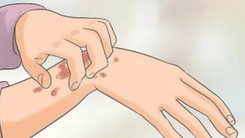Eye socket pain is a sign that can occur in many different diseases. It can be a sign of a serious illness and can severely affect vision if not detected and treated early
1. What is eye socket pain?
The eye socket is made up of several bones, including the upper jaw, forehead bone, cheekbone, lacrimal bone, ethmoid bone, and sphenoid bone. Inside the eye socket, there are soft tissues, including the optic nerve, blood vessels, ocular muscles, and eyeball...
Eye socket pain can be caused by various factors. It may also be a sign of a dangerous condition, such as orbital cellulitis, intraocular hypertension, or tumors, that requires early detection and treatment to prevent serious complications.
2. Causes of eye socket pain
Eye socket pain can be a symptom caused by issues related to the components inside the eye socket. It may also be a manifestation of diseases in other organs. Below are common causes of eye socket pain:
2.1 Orbital cellulitis
This condition is caused by infection of the soft tissues within the eye socket and surrounding muscles due to pathogens such as bacteria, viruses, or fungi.
Orbital cellulitis is a serious condition that can affect the components that make up the eye socket. If not treated in time, it may lead to irreversible vision loss and even sepsis, which can be life-threatening.
Orbital cellulitis can occur at any age but is more common in children under 7 years old and can worsen quickly in children, increasing the risk of blindness. Symptoms of orbital cellulitis in children include:
- Vision loss
- Swelling and pain in both the upper and lower eyelids, possibly including swelling of the eyebrows and cheeks. Changes in eyelid color (red or purple).
- High fever above 39°C.
- Difficulty moving the eyes and pain during eye movement.
- Bulging eyes and severe pain in the eye socket.
- Fatigue, with the child refusing to play.
2.2 Tumors in the eye socket
Tumors can arise from various tissues and may press on the nerves in the eye socket, causing pain. Tumors can occur at any age and can be benign or malignant.
- Benign tumors: Some benign tumors include hemangiomas, dermoid cysts, fibrous dysplasia in children, and optic nerve tumors in adults...
- Malignant tumors: Some malignant tumors include rhabdomyosarcoma, malignant bone tumors, metastatic cancers, and lymphoma…

2.3 Intraocular hypertension
Intraocular hypertension is a common eye disease, more prevalent in older adults, and can be related to glaucoma. It occurs when the pressure inside the eye increases abnormally, damaging the optic nerve, which can lead to vision loss or blindness if not diagnosed and treated promptly.
Glaucoma is primarily divided into two types:
2.3.1 Open-angle glaucoma
Open-angle glaucoma typically develops slowly and may only show clear symptoms later on. The signs often appear in one eye at a time. Symptoms of open-angle glaucoma may include:
- Blurry vision
- Decreased peripheral vision, causing tunnel vision (only seeing the area directly in front of you)
- Red eyes, eye pain, and discomfort
- Some people may also experience headaches.
2.3.2 Angle-closure glaucoma
Angle-closure glaucoma has three forms: acute, subacute, and chronic. Chronic angle-closure glaucoma is very rare and develops slowly, with symptoms similar to open-angle glaucoma. Acute and subacute angle-closure glaucoma develop suddenly and include the following signs:
- Severe vision loss, seeing a halo around lights
- Severe headache, intense eye socket pain
- Eye pain, redness
- Nausea and vomiting
Vision loss due to glaucoma is irreversible. Therefore, regular eye exams are necessary to screen for the disease. Early detection can prevent or slow down the progression of vision loss. The treatment for these two forms of glaucoma is different, so an accurate diagnosis of either open-angle or angle-closure glaucoma is essential for appropriate treatment.
2.4 Eye injury
After direct or indirect trauma to the eye socket, conditions such as hemorrhage in the eyeball, bruising of the eye tissues, or foreign objects in the eye socket may occur. Eye socket pain following trauma can have various causes, so it's essential to seek medical attention to identify the reason quickly.
2.5 Infectious diseases
Pain in the eye socket can also be a sign of other conditions, such as:
- Sinusitis: Particularly frontal sinusitis is a common cause of eye socket pain, which worsens when bending the head down. In addition to eye socket pain, patients may experience nasal discharge and fever.
- Dengue fever: This virus-induced disease, transmitted by mosquito bites, causes high fever, body aches, and eye socket pain during the early stage.
- Viral fever: Besides dengue fever, other viral fevers can also cause symptoms such as fever, body aches, and eye socket pain...
Infectious diseases typically cause high fever, with the main symptoms not being eye socket pain, and the pain may be intermittent, unlike orbital infections, where pain is constant and accompanied by other eye-related symptoms.
2.6 Vasculitis
Vasculitis in the eye socket can cause eye socket pain and other systemic symptoms like fever.
2.7 Venous dilation
Dilation of the veins in the eye socket can lead to blood congestion, causing the eyes to bulge and resulting in eye socket pain. When experiencing venous dilation, the patient should rest and avoid overusing their eyes.
2.8 Graves' disease
Graves' disease is a hyperthyroid condition linked to autoimmune factors, one of the effects of which is eye bulging, though the exact cause of this is unclear. This condition causes pain in both eye sockets, eye bulging, difficulty moving the eyes, sensitivity to light, eye irritation, watering eyes or dryness, puffiness, and blurry or double vision. Other symptoms may include rapid heart rate, heat intolerance, sweating, an enlarged thyroid, excessive eating, and weight loss.
2.9 Graves' disease causing eye socket pain
Graves' disease can lead to eye bulging, light sensitivity, watery eyes, and sometimes a burning sensation in the eyes. The lower eyelid may swell, and the eyelid may become paralyzed, preventing it from closing properly, which can lead to complications like corneal ulcers and dry eyes.
2.10 Other systemic conditions
Conditions like hypertension and diabetes can cause complications in the eyes, leading to eye socket pain.

3. What to do when experiencing eye socket pain?
There are many causes of eye socket pain. If you experience eye socket pain accompanied by symptoms such as blurred vision, severe pain, high fever, bulging eyes, or prolonged pain, especially in children, it is important to visit a healthcare facility for an examination and early treatment to prevent complications.
We hope this article helps you understand what causes eye socket pain and how to recognize when immediate treatment is needed to prevent complications. Regular eye check-ups are crucial for early detection of conditions that may not show clear symptoms, ensuring early access to treatment.
To arrange an appointment, please call HOTLINE or make your reservation directly HERE. You may also download the MyVinmec app to schedule appointments faster and manage your reservations more conveniently.










